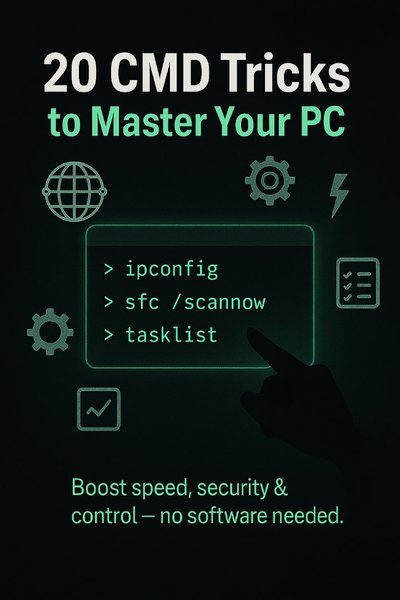Ever felt your PC is holding secrets from you? That it could do more than just run apps or browse the web? That’s exactly what the Command Prompt (CMD) lets you do — safely, efficiently, and with purpose.
Before diving into commands, here’s what you need to know:
- What CMD does: It’s a direct communication line with your PC, giving you access to functions hidden behind menus.
- Why you should care: CMD lets you troubleshoot, optimize, and explore Windows in ways most people never try.
- Safety first: Some commands require administrator access; they can change system settings. Always read the explanation and warnings before running any command.
- Expected outcomes: Each command below is paired with what you should see after executing it, so you know it worked.
Now, let’s explore 20 practical, safe, and powerful CMD tricks — grouped into Network & Internet, System Health & Optimization, and Productivity & Hidden Tools.
Category 1: Network & Internet Tricks
1. Refresh Your Internet Lookup
Scenario: Your browser is loading outdated pages or redirecting oddly.
Why it matters: Windows caches website addresses (DNS cache) to speed up browsing, but old entries can cause slowness.
Command (Admin):
ipconfig /flushdns
Expected outcome: Your PC clears old DNS entries. Browsing should feel faster and more reliable.
2. Renew Your IP Address
Scenario: Wi-Fi shows “Connected, no internet.”
Why it matters: Sometimes your PC needs a new IP from your router.
Command (Admin):
ipconfig /release
ipconfig /renew
Expected outcome: Your connection refreshes. Most connectivity problems are solved immediately.
3. Reset Winsock
Scenario: All apps can’t connect to the internet.
Why it matters: Winsock governs network requests; malware or VPNs can corrupt it.
Command (Admin):
netsh winsock reset
Safety tip: Reboot after running.
Outcome: Internet connections often return to normal instantly.
4. Reset TCP/IP Stack
Scenario: Persistent network issues.
Command (Admin):
netsh int ip reset
Why it matters: Resets network settings to defaults.
Outcome: Your PC network is rebuilt from scratch, often resolving stubborn issues.
5. Check Real Wi-Fi Speed
Scenario: Internet feels slow despite a strong signal.
Command:
netsh wlan show interfaces
What to look for: Receive rate (Mbps) — your actual download speed.
6. Test Your Connection
Scenario: Wondering if your PC or ISP is causing slowness.
ping google.com
Outcome: Shows latency in milliseconds. Low numbers = fast; high numbers = lag.
7. Trace Network Path
Scenario: Streaming or video calls lag.
pathping google.com
What it does: Shows every hop your data takes and where delays occur.
8. Check DNS Resolution
Scenario: A website won’t load, others work.
nslookup example.com
Outcome: Confirms if DNS translates the site name correctly.
9. List Active Connections
Scenario: Curious about apps using the network.
netstat -ano
Pro tip: Combine with tasklist | findstr <PID> to identify programs.
10. Close a Stubborn App
Scenario: A program hangs or freezes.
taskkill /PID <PID> /F
Outcome: Forces the app to close. Use PID from Tip 9.
Category 2: System Health & Optimization
11. Repair System Files
Scenario: Random crashes or misbehaving features.
sfc /scannow
Why: Scans and repairs corrupted Windows files.
Outcome: Restores PC stability.
12. Deep System Repair
Scenario: SFC didn’t fix everything.
DISM /Online /Cleanup-Image /RestoreHealth
Tip: Run SFC afterward. Fixes deeper system corruption.
13. Generate Battery Report
Scenario: Laptop battery seems weaker.
powercfg /batteryreport
Outcome: HTML report shows battery health and expected lifespan.
14. Analyze Power Usage
Scenario: Laptop runs hot or drains fast.
powercfg /energy
Outcome: HTML report highlights power-hungry apps and devices.
15. Free Disk Space (Disable Hibernate)
Scenario: Need extra storage, don’t use hibernate.
powercfg /hibernate off
Undo: powercfg /hibernate on
Outcome: Recovers several GB from hiberfil.sys.
16. Automate Disk Cleanup
Scenario: Repetitive cleanup tasks.
cleanmgr /sageset:1
cleanmgr /sagerun:1
Outcome: Cleans temporary files and old data automatically.
17. Compress Windows OS
Scenario: Low storage, modern CPU available.
compact /compactOS:always
Undo: compact /compactOS:never
Outcome: Saves several GB without losing functionality.
18. List Installed Drivers
driverquery /v
Tip: Add | clip to copy output instantly. Useful for troubleshooting.
Category 3: Productivity & Hidden Tools
19. Copy Output Instantly
ipconfig /all | clip
Outcome: Sends output to clipboard for easy sharing or notes.
20. Refresh Local Device Cache
arp -a
arp -d *
Scenario: Devices vanish after network changes.
Outcome: PC relearns local devices, fixing detection issues.
Mentor’s Advice
- Start with one or two commands at a time.
- Admin commands are powerful; if unsure, pause and ask.
- Reboot after network or system changes for full effect.
- Track your results: notice improvements and tweak safely.
By the end of this guide, your PC will feel faster, smarter, and more under your control — all without guessing, fear, or unnecessary complexity.
💬 Your Turn to Share & Ask!
I’ve shown you 20 CMD tricks to unlock hidden powers on your PC, but the world of Command Prompt is huge — and there’s always more to discover.
Join the conversation:
•
Do you know a CMD trick that’s not on this list?
•
Is there something you’ve always wanted to do with CMD but weren’t sure how?
Drop your prompts, questions, or favorite commands in the comments below, and we’ll explore them in future tutorials. Your idea could be the next game-changing tip someone else needs!
Let’s learn together, share knowledge, and make mastering CMD fun and approachable for everyone.




Comments (0)
Leave a Comment
No comments yet. Be the first to comment!